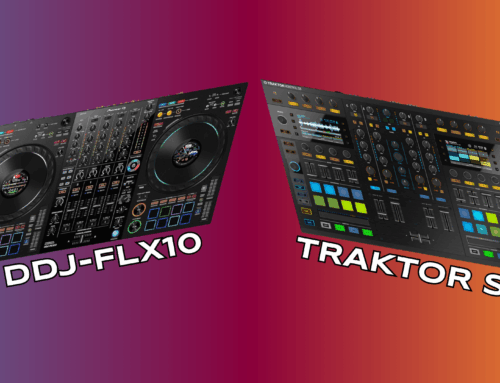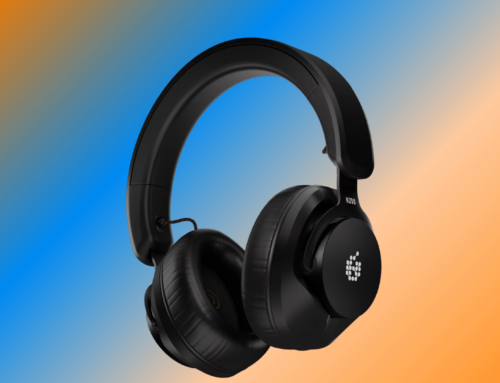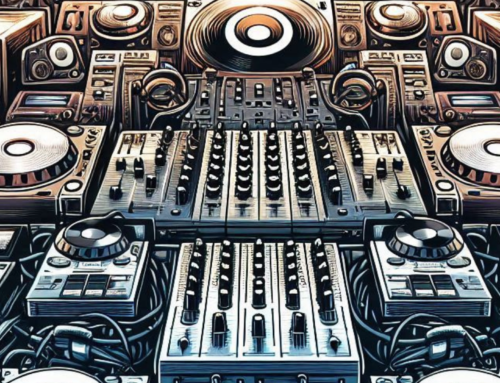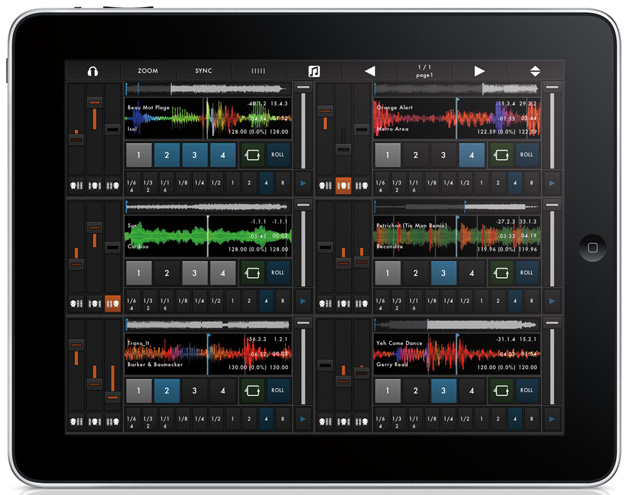 Do you remember when Prince changed his name to a symbol and everyone referred to him as the “artist formerly known as Prince”? Well, that situation reminds me of the recent iPad DJ app from the German company “Zerodebug”. The app doesn’t really have a name, just a symbol: d(- -)b. Clearly, I get that this symbol represents a DJ with headphones on, but if I bump into one of my fellow DJ friends on the street, how am I supposed to tell him about this cool new app? “Hey buddy, you gotta check out the new d open parenthesis dash dash close parenthesis b app.” Do I call it “db,” “doob,” or that DJ app from Zerodebug? D(- -)b (see, I can’t even start a sentence with the app’s name) loses points with me right away for not having a real name. Fortunately, d(- -)b makes up for it with some groundbreaking features never before seen in a DJ app.
Do you remember when Prince changed his name to a symbol and everyone referred to him as the “artist formerly known as Prince”? Well, that situation reminds me of the recent iPad DJ app from the German company “Zerodebug”. The app doesn’t really have a name, just a symbol: d(- -)b. Clearly, I get that this symbol represents a DJ with headphones on, but if I bump into one of my fellow DJ friends on the street, how am I supposed to tell him about this cool new app? “Hey buddy, you gotta check out the new d open parenthesis dash dash close parenthesis b app.” Do I call it “db,” “doob,” or that DJ app from Zerodebug? D(- -)b (see, I can’t even start a sentence with the app’s name) loses points with me right away for not having a real name. Fortunately, d(- -)b makes up for it with some groundbreaking features never before seen in a DJ app.
![]() The unique thing about d(- -)b is that it is the first modular DJ app. By modular, I mean you can basically build your own DJ app using all of d(- -)b’s features and laying them out in any arrangement that you wish. You can put the waveforms here, add the play buttons there, throw the cue buttons over there, make the pitch slider stretch the entire length of the iPad, and so on. I have to say, this is a very unique concept, and it functions very well. You can pretty much put the various elements anywhere you like, and resize them any way you like. You can make your custom app super simple, or you could cram everything onto one screen for an all-out, ultra-cluttered DJ interface. Once you get everything just right, the layout can be saved for future use. I really enjoyed playing around with this feature, as it is very intuitive and everything seems to function well.
The unique thing about d(- -)b is that it is the first modular DJ app. By modular, I mean you can basically build your own DJ app using all of d(- -)b’s features and laying them out in any arrangement that you wish. You can put the waveforms here, add the play buttons there, throw the cue buttons over there, make the pitch slider stretch the entire length of the iPad, and so on. I have to say, this is a very unique concept, and it functions very well. You can pretty much put the various elements anywhere you like, and resize them any way you like. You can make your custom app super simple, or you could cram everything onto one screen for an all-out, ultra-cluttered DJ interface. Once you get everything just right, the layout can be saved for future use. I really enjoyed playing around with this feature, as it is very intuitive and everything seems to function well.
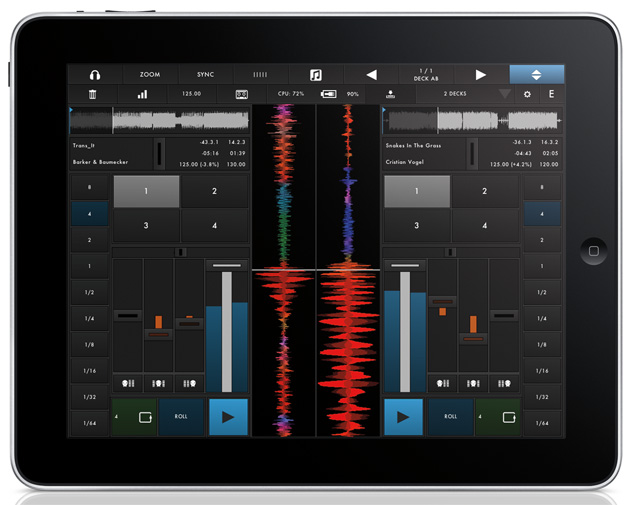
If you don’t feel like spending time tweaking the modular elements to your liking, you can choose from pre-installed templates containing up to 4 individual decks. For most of my time playing around with the app, I stuck with the standard 2 deck template. I found this default layout to be very clean and user friendly. Unlike most DJ apps, which typically use jog wheels to manipulate tracks, d(- -)b uses touch-sensitive waveforms that vertically stretch the entire length of the iPad. This was a feature that I really enjoyed. I’m a fan of mixing without using the sync button, and the touch-sensitive, color coded waveforms allowed me to nudge the track faster or slower to dial in the right tempo for the mix. Along with the nudgable waveforms, d(- -)b also features 2 tempo sliders on each deck. The “coarse” slider allows adjustments up to + or – 10%, and the “fine” slider allows you to dial in the perfect tempo with adjustments up to + or – 1%. The d(- -)b app doesn’t really have “key lock” but it must have some sort of key protection built in. When playing around with the app, I noticed that a track at +10% didn’t sound perfect, but sounded better than it should have at that amount of adjustment. For those DJs who are not ashamed to hit the “sync” button, d(- -)b has one of those as well, and it functions just like it should. While mixing around with d(- -)b, I was very pleased at the responsiveness of the app and its low latency. Like most iPad DJ apps, the scratching” sounded too “digital”, but the other general mixing features more than made up for this shortcoming.
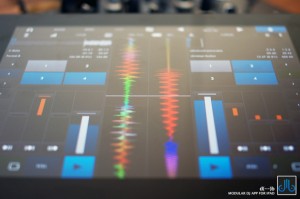
In addition to all of the tempo adjustment and mixing features, d(- -)b has some really great looping and cue point features. Each deck features 4 individual cue points that are able to be set on the fly. These buttons were very responsive and functioned perfectly. The looping section allows you to loop a section from 1/64th of a measure (or bar) all the way up to 8 measures. Again, this feature functioned very well, and by sliding your finger from one loop length button to the next, it’s easy to create a “build-up” effect by continually shortening the loop length. The option of “loop rolling” also is included in this section. Each deck has a 3 band EQ with kill buttons, but unfortunately there are no effects whatsoever built into the d(- -)b app.
I could tell that d(- -)b was a very well designed app by the attention given to the important details, including analyzing and “beat-gridding” the tracks. The d(- -)b app does a great job of this when a track is loaded to a deck, and also allows for manual beat-gridding of individual tracks by entering an expanded editing mode. I really enjoyed this feature and found that it also came in handy when setting precise cue points.
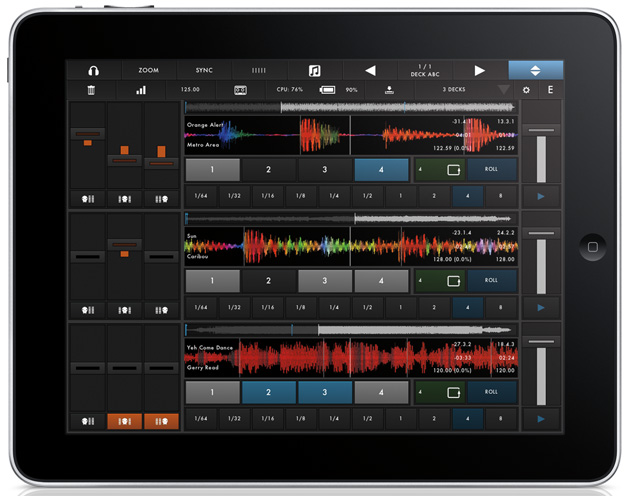
Overall, d(- -)b is a great DJ app with the added benefit of modular customization. I really liked the simplicity of the interface, and was pleased with the responsiveness of the waveform display. I did have a few issues with the volume dropping out when I was working in the modular section, but other than that, d(- -)b is a very stable app (it even has a CPU usage meter at the top of the screen). Unlike some other DJ apps, the settings section is not overwhelming, and makes it easy to adjust the important things, like audio output modes. I really enjoyed my time with d(- -)b, and even though I still think the name is stupid, I feel that this is one of the better iPad DJ apps on the market today.

